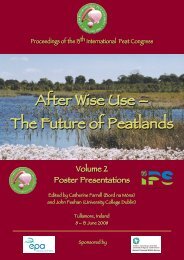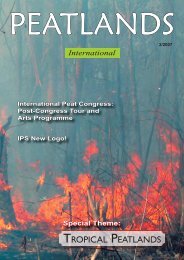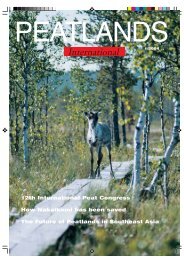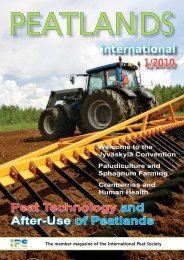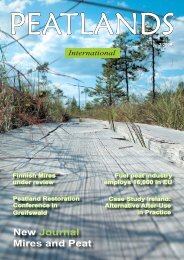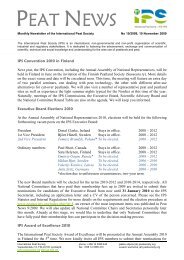peatlands 1 taitto.indd - International Peat Society
peatlands 1 taitto.indd - International Peat Society
peatlands 1 taitto.indd - International Peat Society
You also want an ePaper? Increase the reach of your titles
YUMPU automatically turns print PDFs into web optimized ePapers that Google loves.
The Imnati Mire in the Kolkheti<br />
Lowland in Georgia Text and photos: Andreas Haberl,<br />
Marina Kahrmann, Matthias Krebs,<br />
Izolda Matchutadze and Hans Joosten<br />
Imnati, the largest mire in<br />
Georgia, is a worldwide<br />
unique percolation bog with<br />
a characteristic vegetation of<br />
Saw grass and peat mosses.<br />
In spite of its status as a<br />
National Park and Ramsar<br />
site, the mire is threatened<br />
by human activities.<br />
The Kolkheti (Colchis) area in Western<br />
Georgia (Caucasus) at the coast of the<br />
Black Sea is known for its extensive<br />
and special mires that - situated between<br />
citrus groves and tea plantations<br />
- form a structural and functional transition<br />
between the mires of the boreal<br />
and those of the tropical zones (Joosten<br />
et al. 2003). The special character of<br />
the area and its mires brought Botch &<br />
Masing (1983) and Succow & Joosten<br />
(2001) to the distinction of a specifi c<br />
Kolkheti mire region within Eurasia.<br />
The characteristic mire type of this<br />
region is the percolation bog (Joosten<br />
& Clarke 2002), a dome-shaped Sphagnum<br />
mire only fed by precipitation,<br />
that – in contrast to bogs in other parts<br />
of the world - has slightly humifi ed<br />
and highly permeable peat over its total<br />
depth. This allows water to percolate<br />
through the whole peat body (Lamme<br />
2006). The absence of substantial<br />
surface-water<br />
fl ow prevents the<br />
differentiation of<br />
hummocks and<br />
hollows (Couwenberg<br />
& Joosten<br />
2005) giving these<br />
mires their typical<br />
smooth surface.<br />
The existence<br />
of percolation<br />
bogs in the<br />
Kolkheti lowland<br />
was - on theoretical<br />
grounds - predicted<br />
on the basis<br />
of the prevailing extremely high and<br />
continuous precipitation (Couwenberg<br />
& Joosten 1999). The worldwide fi rst<br />
percolation bog that was discovered<br />
and intensively studied was the mire<br />
Ispani 2 near Kobuleti in the southern<br />
part of the Kolkheti lowland (Kaffke<br />
et al. 2000).<br />
In order to test and improve the<br />
concept of percolation bog, the<br />
Imnati mire, with similar morphological<br />
features, was<br />
focus of further<br />
research.<br />
Imnati is situated<br />
in the centre<br />
of the Kolkheti<br />
lowland 30 km<br />
north of Ispani 2<br />
close to the Black<br />
Sea (Fig.1). The<br />
climate is characterised<br />
by continuousprecipitation<br />
(1661 mm<br />
a -1 ) and a high<br />
humidity (80%),<br />
with a high mean<br />
annual temperature<br />
(14.1°C) and<br />
hardly any frost.<br />
Imnati constitutes,<br />
with 5000<br />
ha of non forested mire, 11% of the<br />
peatland area in Georgia. It is part of<br />
the “Wetlands of Central Kolkheti”<br />
Ramsar site designated in 1997 and is<br />
incorporated in the Kolkheti National<br />
Park which was established in 1999.<br />
Imnati consists of two separate bog<br />
cupolas. The western cupola (Fig.2)<br />
was studied in detail in 2004 and 2005<br />
by Greifswald University (Germany)<br />
in cooperation with the Integrated<br />
Coastal Zone Management (ICZM)<br />
Centre Tbilisi, the Kolkheti National<br />
Park, and the Georgian botanist Izolda<br />
Matchutadze (Kahrmann & Haberl<br />
2005).<br />
<strong>Peat</strong> formation<br />
<strong>Peat</strong> formation in Imnati began approx.<br />
6000 BP (Nejstadt et al. 1965).<br />
Before that, the area was a lagoon<br />
separated from the Black Sea by a spit<br />
build up of sediments from the Rioni<br />
River. Over the clay and silt sediments<br />
of the lagoon, a peat body of 3 to 12<br />
m depth accumulated (Fig.3). The peat<br />
Fig. 1, top left: Imnati mire in the Kolkheti lowland (Western Georgia)<br />
Fig. 2, above: Map of Imnati mire with the locations of the transects.<br />
35



